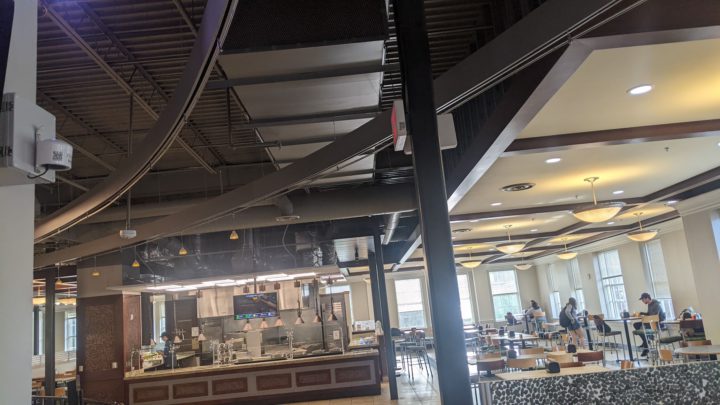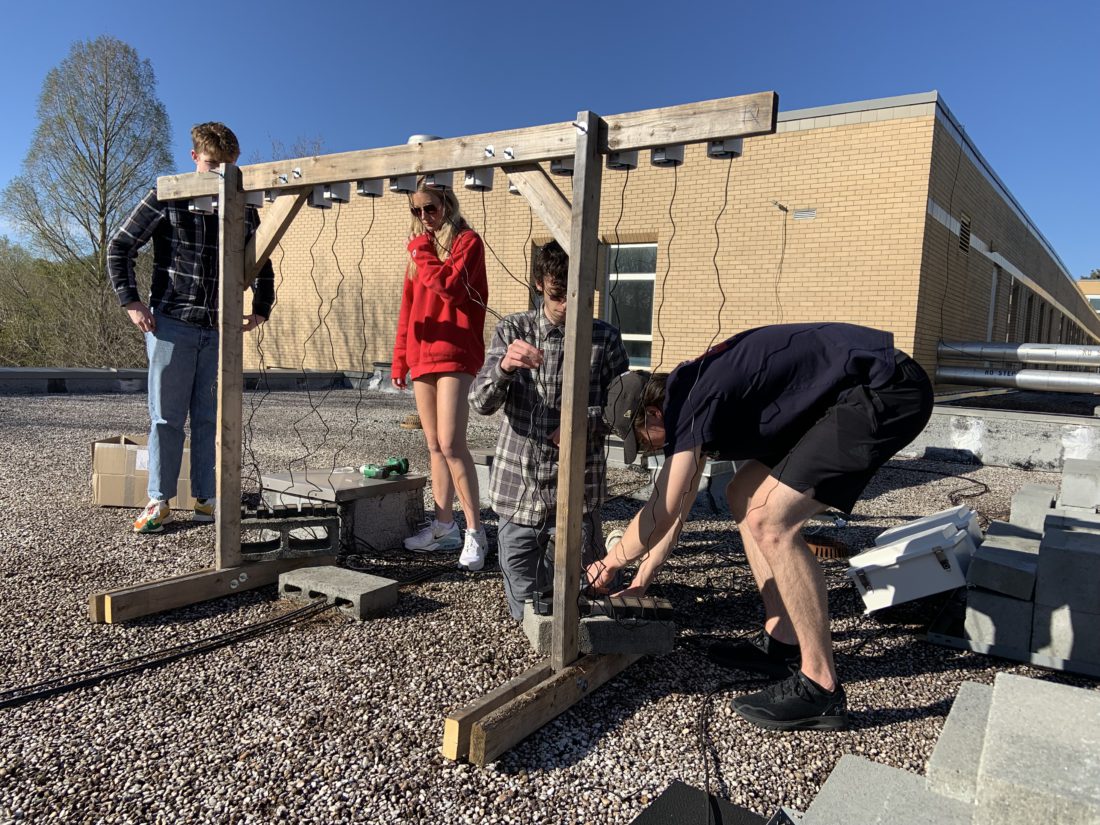Western North Carolina’s mountain air has attracted people to the region at least as far back as Colonial America, when plantation owners in Georgia and South Carolina came to escape the hot, humid, mosquito-infested summers. In the late 19th century, Asheville was even dubbed “the Switzerland of America” for the potential of its air to soothe the lungs of tuberculosis patients.
By the turn of this century, however, air quality in the region was no longer so idyllic. Visibility from key lookout points in the Great Smoky Mountains could be as low as 1 mile on the haziest days. The primary culprits were fine particulate matter — composed of pollutants like emissions and better known as PM 2.5 — and ground-level ozone, which results when nitrogen oxides and volatile organic compounds react in intense sunlight. Statewide, ground-level ozone exceeded national standards an average of 100 days per year in 2000.
By 2017, however, that average had fallen to seven days per year. Here in Buncombe County, high ozone levels occur only one or two days per year, says Ashley Featherstone, Asheville-Buncombe Air Quality Agency director. Local air quality regularly measures between 0 and 50, or “good,” on the U.S. Environmental Protection Agency’s official Air Quality Index scale. Anything above 151 is considered unhealthy for the general population.
Featherstone says that this improvement is the result of sustained efforts from federal and state clean air policies and local enforcement by agency officials. “It’s so much cleaner now, [but that] doesn’t mean we don’t need to keep it that way,” she says.
While Featherstone and agency staff focus on the big-picture aspects of collecting data to inform policymaking and implementing those regulations, university researchers in the region are increasingly focusing on local differences in air quality.
“We’re realizing that air pollution is a local issue, sometimes even a hyperlocal issue,” says Sara Duncan, assistant professor in the environmental health program at Western Carolina University. Her research has shown that air quality can vary significantly within as little as 300 feet.
In this article, Xpress looks at the variety of efforts to address air quality in the region, now and in the future .
Measuring improvement
Buncombe County is one of only three counties in the state to set up a local enforcement arm and to assume oversight of EPA grants rather than rely on the state. The county also can issue federally enforced permits. (The other two counties with local air programs are Mecklenburg and Forsyth.)
Buncombe County monitors ozone in Bent Creek, PM 2.5 at the Board of Education building and volatile organic compounds at AB Tech’s main campus.

Featherstone says that one of the most important policies over the last 20 years is the 2002 Clean Smokestacks Act, which required the state’s 14 power plants to reduce nitrous oxide and sulfur dioxide emissions. By 2021, emissions of these two gases were reduced by 80%. Visibility on Purchase Knob in Haywood County grew by 30.1 miles from 2005-21 as a result, according to the N.C. Department of Environmental Quality’s Division of Air Quality.
As the power plants have become cleaner (and greener), mobile emissions are now probably the most important source of fine particulate matter in the region, according to Evan Couzo, associate professor of atmospheric sciences and STEM education at UNC Asheville. This includes not only vehicular emissions but also road dust and pieces of tire. When inhaled, PM 2.5 — solid and liquid droplets measuring 2.5 microns in diameter or less — can damage the lungs and aggravate diseases like asthma, chronic obstructive pulmonary disease and even heart disease, according to multiple studies.
Unequal risks of exposure
As important as the regulatory monitors are, they do not reflect local variations in air quality, says Couzo. “If we want to understand how different neighborhoods are impacted, we need a denser monitoring network,” he explains.
“Air quality improvement is a national success story. There’s no question that our air has become cleaner and less polluted,” he adds. “The question now is: ‘Have improvements been distributed equitably?’”
Couzo recently received funding for two projects that will explore equity in air quality in Asheville. An EPA grant will enable Couzo and his students to build low-cost sensors and place them around Asheville City Schools in select neighborhoods. They plan to compare data from neighborhoods subject to historic discrimination in housing policy with wealthier neighborhoods to see if there is a difference in air quality.
“This is going to allow us to understand if risk of exposure is different depending on whether you live in a neighborhood that was discriminated against or not,” he says.
The second project, funded by UNC Asheville, will place low-cost sensors, known as PurpleAir monitors, in both public housing and wealthier communities. These sensors will measure not only air quality but also temperature and humidity.
“Heat waves and periods of extreme heat and high humidity are deadly. When you look at public housing neighborhoods, you see a lot

of asphalt; you don’t see a lot of tree cover,” he says. “So, you’ve got risk of exposure from local emissions and the potential for high heat stress.” Moreover, Couzo says that more frequent, more intense heat also increases the risk of ground-level ozone forming.
While Couzo’s efforts are focused on urban Asheville, Duncan is looking at the effects of air quality inequity in rural areas of the region, where “there’s a lot of poverty, low-quality housing, and difficulties in getting around because of lack of public transportation.”
“A lot of people assume, ‘We’re in the mountains. So, air quality is good, right?’” Duncan says. “It might be good on the other side of the bridge, but it might be bad where you are. You could be exposed to a completely different amount of pollution with a 500-foot difference in elevation.”
Her research focuses on the effects of prescribed burns on local PM 2.5 exposure, using data from the EPA, PurpleAir monitors and NASA’s Fire Information Resource Management System, all of which are open source and available to anyone. “Ideally, the smoke will move upward, so you get lots of dispersion quickly of that particulate matter. But that doesn’t always happen, so you can get really high localized exposures to particulate matter,” she says. (Ground ozone is less hyperlocalized in nature, she notes.) She is hoping that her research can pave the way for targeted warning systems to alert residents to prescribed burns “like a winter weather advisory,” she explains.
She also stresses that prescribed burns and forest fires — which she says are likely to increase with climate change — can impact indoor air quality. The poorer the insulation, the more likely it is that outdoor air can infiltrate. Over 90% of the average American’s time is spent indoors, Duncan says.
In fact, many calls to the Asheville Buncombe Air Quality Agency concern indoor pollution, says Featherstone. Specifically, people inquire about wood-burning stoves. “You would be surprised how many stoves are out there today that are not meeting older [Clean Air Act] standards that went into effect around 1990,” Featherstone says. The agency often directs people to the EPA’s Burn Wise program, which offers tips and even funds to help people burn wood more cleanly.
The future of mountain air
When asked to name the biggest threat to local air quality, Featherstone, Duncan and Couzo all noted climate change. As summers get hotter and drier, the likelihood of more forest fires producing PM 2.5 and hotter summers creating more ground-level ozone increases.
Featherstone also believes that PFAS, known as “forever chemicals,” will become an increasing concern and require more regulation. The challenge, she says, is that more advanced technology will be needed, since PFAS can be toxic in amounts as small as parts per trillion, as opposed to parts per billion for PM 2.5 and ozone.
On a more prosaic level, funding cuts have hampered the Air Quality Agency’s work. “Our funding has been flat since 2004, which is about the equivalent of a 20% cut,” Featherstone adds. “So, we’ve got a lot less people than we had back then but more rules to implement and more work.”
Even so, the agency is working on a variety of new initiatives, many related to climate change programs enacted by the Inflation Reduction Act. “We’ve been working with Buncombe County Schools and looking at things like the electric school buses, [and] there’s money (available) for replacing diesel buses with electric buses,” Featherstone says. Other potential projects include implementing a proposed statewide Advanced Clean Trucks program. If adopted, this program would support investments in charging infrastructure and workforce development, as well as purchase incentives to offset the greater costs of purchasing electric ambulances and other large trucks.
Couzo also cites new federal funding as a reason to be optimistic about the future of the region’s air quality. “It’s going to take a lot to actually degrade our air quality,” he says.
“I honestly just don’t see things getting worse. As we electrify vehicles, those emissions will go away. I don’t think we’re going to build any more coal-fired power plants. So, since the Inflation Reduction Act passed last summer, I’ve actually been pretty optimistic.”




Before you comment
The comments section is here to provide a platform for civil dialogue on the issues we face together as a local community. Xpress is committed to offering this platform for all voices, but when the tone of the discussion gets nasty or strays off topic, we believe many people choose not to participate. Xpress editors are determined to moderate comments to ensure a constructive interchange is maintained. All comments judged not to be in keeping with the spirit of civil discourse will be removed and repeat violators will be banned. See here for our terms of service. Thank you for being part of this effort to promote respectful discussion.